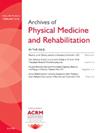Technology-Based Physical Rehabilitation for Balance in Patients With Multiple Sclerosis: A Systematic Review and Meta-analysis
IF 3.7
2区 医学
Q1 REHABILITATION
Archives of physical medicine and rehabilitation
Pub Date : 2025-09-01
DOI:10.1016/j.apmr.2025.02.011
引用次数: 0
Abstract
Objective
To synthesize the current evidence on technology-based physical rehabilitation for balance in people with multiple sclerosis and to compare its effectiveness with that of conventional physical therapy.
Data Sources
A comprehensive search of databases including CENTRAL Scopus, CINAHL, PsycINFO, PubMed, and PEDro was conducted up to March 2024.
Study Selection
Studies were selected based on predefined inclusion criteria.
Data Extraction
Data extraction and quality assessment were performed independently by 2 reviewers. Statistical analyses were conducted using a random effects model.
Data Synthesis
A total of 24 studies involving 985 participants were included. The meta-analysis revealed that compared with conventional physical therapy, technology-based physical rehabilitation significantly improved balance outcomes by 0.16 (95% CI, 0.04- 0.29; P=.027) with moderate heterogeneity (I²=39.1%). Subgroup analyses were performed by intervention modality (robotic assistive gait training, exergaming, and telerehabilitation), and only exergaming interventions had a medium effect on balance in this population of 0.29 (95% CI, 0.08-0.251; P=.03).
Conclusions
Among technology-based physical rehabilitation approaches, exergaming interventions have shown promising effectiveness in improving balance in people with multiple sclerosis. Despite the moderate heterogeneity, the findings support the use of exergaming as a viable option. Further high-quality randomized controlled trials are needed to confirm these results.
基于技术的物理康复对多发性硬化症患者的平衡:系统回顾和荟萃分析。
目的:综合目前基于技术的多发性硬化症患者平衡康复的证据,并将其与常规物理治疗的效果进行比较。数据来源:截至2024年3月,对CENTRAL Scopus、CINAHL、PsycINFO、PubMed、PEDro等数据库进行了全面检索。研究选择:根据预定义的纳入标准选择研究。数据提取:数据提取和质量评估由两名审稿人独立完成。采用随机效应模型进行统计分析。数据综合:共纳入24项研究,涉及985名受试者。meta分析显示,与传统物理治疗相比,以技术为基础的物理康复可显著改善平衡结果0.16(95%可信区间:0.04,0.29;p = 0,027)具有中等异质性(I² = 39.1%)。通过干预方式(机器人辅助步态训练、运动和远程康复)进行亚组分析,只有运动干预对该人群的平衡有中等影响,为0.29(95%可信区间:0.08,0.251;p = 0,03)。结论:在基于技术的物理康复方法中,运动干预在改善多发性硬化症患者的平衡方面显示出有希望的效果。尽管存在适度的异质性,但研究结果支持将运动作为一种可行的选择。需要进一步的高质量随机对照试验来证实这些结果。
本文章由计算机程序翻译,如有差异,请以英文原文为准。
求助全文
约1分钟内获得全文
求助全文
来源期刊
CiteScore
6.20
自引率
4.70%
发文量
495
审稿时长
38 days
期刊介绍:
The Archives of Physical Medicine and Rehabilitation publishes original, peer-reviewed research and clinical reports on important trends and developments in physical medicine and rehabilitation and related fields. This international journal brings researchers and clinicians authoritative information on the therapeutic utilization of physical, behavioral and pharmaceutical agents in providing comprehensive care for individuals with chronic illness and disabilities.
Archives began publication in 1920, publishes monthly, and is the official journal of the American Congress of Rehabilitation Medicine. Its papers are cited more often than any other rehabilitation journal.

 求助内容:
求助内容: 应助结果提醒方式:
应助结果提醒方式:


